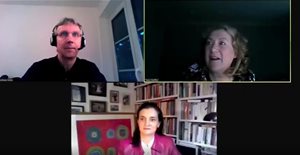
The mRNA manufacturing process is flexible, said Andreas Kuhn, PhD, senior vice president for RNA biochemistry and manufacturing at the German firm BioNTech: “One process can be used to manufacture essentially any mRNA sequence.”
Additional advantages of mRNA therapeutics include that it “allows expression of multiple proteins, and thus targeting of multiple antigens on one RNA or using an RNA mixture,” said Kuhn. Additionally, mRNA can be its own adjuvant since it can be recognized by toll-like receptors and other parts of the signal transfection cascade; alternatively, he said, it can be made “immune-silent.”
Also, mRNA is a stable molecule, with one important caveat: “Just be aware of RNAases!” said Kuhn. Likewise, there is no risk of genomic integration, and since it is degraded into nucleotides, it has no toxic metabolites.
Dialing in the vaccine dose is important from the vaccine manufacturer’s perspective as production scales globally, said Kuhn. “There’s a huge difference where you have a vaccine where you have to manufacture 100 mcg per dose, where you would need 1 ton of RNA” in total, compared with a dose as small as 0.1 mcg, where the total RNA manufactured for 10 billion doses might total just 1 kg.
BioNTech used an all-in strategy to develop COVID-19 vaccines, exploring all three of its RNA types as part of the platform technology and designing multiple antigen variants using the SARS-CoV-2 spike protein “to bring the most active antigen into the clinic,” said Kuhn. The firm focused on manufacturing small batches of vaccine at “light speed” to test for safety, low reactogenicity and immunogenicity of the variants under consideration.
“What has made ‘light speed’ possible?” asked Kuhn. He elaborated that with the availability of a target sequence, a lead candidate can be designed in just a few hours. Then, assuming the ability to scale and produce a quality product, a DNA template can be made within days by means of oligonucleotide synthesis, gene assembly and PCR amplification.
Key to these abilities, though, was the availability of good manufacturing processes- (GMP-) compliant manufacturing for both the RNA and lipid nanoparticles technologies that are essential to vaccine production.
“In addition, from the beginning we had constant interaction with regulatory agencies”, said Kuhn. “This allowed us to have the first GMP batch including analytics within 3 months after the first internal project meeting.”
Those candidates that were faring well in the small-batch phase were manufactured at larger scale in parallel, for use in larger scale clinical trials. Simultaneously, efforts were underway to find partners with whom BioNTech could collaborate for worldwide vaccine production.
At present, BioNTech has already manufactured “dozens” of GMP batches for the firm’s vaccine candidates, and clinical studies for all three RNA types have been approved.
A midsummer evaluation of phase I data brought forward the modRNA vaccine BNT 162b2 as the candidate for further study, said Kuhn. As of the last week of October 2020, participants in the global phase II/III study have been dosed in Argentina, Brazil, Germany, Turkey, South Africa and the US.
Kuhn said next steps will involve “upscaling of manufacturing for pandemic and market supply,” so that production can move from the scale of grams to kilograms and beyond. “That involves things like ensuring the supply of starting materials, so here we are really talking about amounts that are orders of magnitude higher than we have used before,” he said.
The BioNTech team had to accomplish certain process changes for upscaling – and “it’s also about securing manufacturing capacity,” he said. Kuhn said that going forward, the platform should be ready for challenges from emerging diseases, as well as for existing viral illnesses.
Euro Convergence 2020
"light" - Google News
November 05, 2020 at 05:43AM
https://ift.tt/2JAFFlj
Building a vaccine at light speed: mRNA COVID vaccine development - Regulatory Focus
"light" - Google News
https://ift.tt/2Wm8QLw
https://ift.tt/2Stbv5k
Bagikan Berita Ini














0 Response to "Building a vaccine at light speed: mRNA COVID vaccine development - Regulatory Focus"
Post a Comment